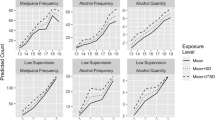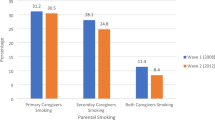Abstract
The present study investigated the role of parental use of alcohol, cigarettes, and marijuana on lagged changes in the specific substance use of their adolescent offspring over a six-year period. The analyses also examined the relative influence of mothers and fathers and their interaction as moderated by marital status and age and gender of the adolescent. A generalized estimating equations approach, analogous to quasi-like-lihood, was employed to estimate regression coefficients via an iterative weighted least squares algorithm. Findings indicated that, when employed as time-varying covariates, parental substance use resulted in substance-specific effects on fluctuations in the adolescent’s own use. Age, parent marital status, and each parent’s marijuana use independently were jound to significantly affect adolescent marijuana use. In contrast, the complex relationship between parent and adolescent use of alcohol and cigarettes showed variation by substance, age, and gender of both parents and adolescents. Within a developmental context, the results suggest that parent use of substances must be considered risk factors with particular effects on their younger offspring. Thus, prevention efforts should be directed at middle childhood and include components aimed at parents as well as their children.
Similar content being viewed by others
References
Ary DV, Tildesley E, Hops E, Andrews J: The influence of parent, sibling, and peer modeling and attitudes on adolescent use of alcohol.International Journal of the Addictions. 1993,28:853–880.
Biglan A, Severson HH, Bavry J, McConnell S: Social influence and adolescent smoking: A first look behind the barn.Health Education. 1983,14:14–18.
Dishion TJ, Loeber R: Adolescent marijuana and alcohol use: The role of parents and peers revisited.American Journal of Drug and Alcohol Abuse. 1985,11:11–25.
Hops H, Smolkowski K, Tildesley E: Friendship stability and quality: Influences of adolescent substance use. In Dishion T (Chair), Peers and problem behavior in adolescence: Interactional and contextual influences. Fourth Biennial Meeting of the Society for Research on Adolescence. Washington, DC: March 1992.
Kandel DB: On processes of peer influences in adolescent drug use: A developmental perspective. In Brook JS, Lettieri DJ, Brook DW, Stimmel B (eds),Alcohol and Substance Abuse in Adolescence. New York: Haworth Press, 1985, 139–163.
Brook JS, Whiteman M, Gordon AS, Brook DW: Father’s influence on his daughter’s marijuana use viewed in a mother and peer context.Advances in Alcohol and Substance Abuse. 1985,4:165–190.
Fisher DG, MacKinnon DP, Anglin MD, Thompson JP: Parental influences on substance use: Gender differences and stage theory.Journal of Drug Education. 1987,17:69–86.
Bandura A:Social Learning Theory. Englewood Cliffs, NJ: Prentice-Hall, 1977.
Bandura A:Social Foundations of Thought and Action: A Social Cognitive Theory. Englewood Cliffs, NJ: Prentice-Hall, 1986.
Conger RD, Reuter MA, Conger KJ: The family context of adolescent vulnerability and resilience to alcohol use and abuse.Sociological Studies of Children. 1994,6:55–86.
Bank BJ, Biddle BJ, Anderson DS, et al: Comparative research on the social determinants of adolescent drinking.Social Psychology Quarterly. 1985,48:164–177.
Biddle BJ, Bank BJ, Marlin MM: Parental and peer influence on adolescents.Social Forces. 1980,58:1057–1059.
Brook JE, Brook JS: A developmental approach examining social and personal correlates in relation to alcohol use over time.Journal of Genetic Psychology. 1987,149:93–110.
Brook JS, Whiteman M, Gordon AS, Cohen P: Some models and mechanisms for explaining the impact of maternal and adolescent characteristics on adolescent stage of drug use.Developmental Psychology. 1986,22:460–467.
Clayton RR, Lacy WB: Interpersonal influences on male drug use and drug use intentions.International Journal of the Addictions. 1982,17:655–666.
Needle R, Lavee Y, Su S, Brown P, Doherty W: Familial, interpersonal, and intrapersonal correlates of drug use: A longitudinal comparison of adolescents in treatment, drug-using adolescents not in treatment, and non-drug-using adolescents.International Journal of the Addictions. 1988,23:1211–1240.
Needle R, McCubbin H, Wilson M, et al: Interpersonal influences in adolescent drug use: The role of older siblings, parents, and peers.International Journal of the Addictions. 1986,21:739–766.
Green G, Macintyre S, West P, Ecob R: Like parent like child? Associations between drinking and smoking behaviour of parents and their children.British Journal of Addiction. 1991,86:745–758.
Byram OW, Fly JW: Family structure, race, and adolescents’ alcohol use: A research note.American Journal of Drug and Alcohol Abuse. 1984,10:467–478.
Hops H, Tildesley E, Lichtenstein E, Ary D, Sherman L: Parentadolescent problem-solving interactions and drug use.American Journal of Drug and Alcohol Abuse. 1990,16:239–258.
Hawkins JD, Catalano RE, Miller JY: Risk and protective factors for alcohol and other drug problems in adolescence and early adulthood: Implications for substance abuse.Prevention Psychological Bulletin. 1992,112(1):64–105.
Andrews JA, Hops H, Ary D, Tildesley E, Harris J: Parental influence on early adolescent substance use: Specific and non-specific effects.Journal of Early Adolescence. 1993,13:285–310.
Brook JS, Whiteman M, Gordon AS: Qualitative and quantitative aspects of adolescent drug use: Interplay of personality, family, and peer correlates.Psychological Reports. 1982,51:1151–1163.
Kandel DB, Andrews K: Processes of adolescent socialization by parents and peers.International Journal of the Addictions. 1987.22:319–342.
Thompson KM, Wilsnack RW: Parental influence on adolescent drinking: Modeling, attitudes, or conflict?.Youth & Society. 1987,19(1):22–43.
Duncan TE, Duncan SC, Hops H, Stoolmiller M: An analysis of the relationship between parent and adolescent marijuana use via generalized estimating equation methodology.Multivariate Behavioral Research (in press, 1996).
Zeger SL, Liang K: Longitudinal data analysis for discrete and continuous outcomes.Biometrics. 1986,42:121–130.
Duncan TE, McAuley E, Stoolmiller M, Duncan SC: Serial fluctuations in exercise behavior as a function of social support and efficacy cognitions.Journal of Applied Social Psychology. 1993,23:1498–1522.
Hollingshead AB:Four Factor Index of Social Status. New Haven, CT: Yale University Working Paper, 1975.
Kandel DB: Marijuana users in young adulthood.Archives of General Psychiatry. 1984,41:200–209.
Newcomb MD, Bentler PM:Consequences of Adolescent Drug Use: Impact on the Lives of Young Adults. Newbury Park, CA: Sage, 1988.
National Institute on Drug Abuse:Overview of the 1988 National Household Survey on Drug Abuse, Rockville, MD: National Institute on Drug Abuse, 1989.
Is Oregon’s Future at Risk? A Profile of Oregon’s Youth. Portland, OR: Oregon Employment Division Research and Statistics, 1989.
Duncan SC, Duncan TE: Modeling incomplete longitudinal data using latent variable growth curve methodology.Multivariate Behavioral Research (in press, 1996).
Duncan TE, Duncan SC, Hops H: The effect of family cohesiveness and peer encouragement on the development of adolescent alcohol use: A cohort-sequential approach to the analysis of longitudinal data.Journal of Studies on Alcohol. 1994,55(5):588–599.
Wedderburn RW: Quasi-likelihood functions, generalized linear models, and the Gauss-Newton method.Biometrika. 1974,61: 439–447.
Cohen J, Cohen P:Applied Multiple Regression/Correlation Analysis for the Behavioral Sciences. Hillsdale, NJ: Erlbaum, 1983.
Aiken LS, West SG:Multiple Regression: Testing and Interpreting Interactions. Newbury Park, CA: Sage, 1991.
Burnside MA, Baer PE, McLaughlin RJ, Pokorny AD: Alcohol use by adolescents in disrupted families.Alcoholism: Clinical and Experimental Research. 1986,10(3):274–278.
Dornbusch SM, Carlsmith JM, Bushwall SJ, et al: Single parents, extended households, and the control of adolescents.Child Development. 1985,56:326–341.
Steinberg L: Single parents, stepparents, and the susceptibility of adolescents to antisocial peer pressure.Child Development. 1987,58:269–275.
Patterson GR, Reid JB, Dishion TJ:Antisocial Boys. Eugene, OR: Castalia, 1992.
Ambert AM: Differences in children’s behavior toward custodial mothers and custodial fathers.Journal of Marriage and The Family. 1982,44(2):73–86.
Hetherington EM, Cox M, Cox R: Divorced fathers.Family Coordinator. 1976,25:417–428.
Andrews J, Hops H, Duncan SC: Adolescent modeling of parent substance use: The moderating effect of the relationship with the parent.Journal of Family Psychology. (in press, 1996).
Johnston LD, O’Malley PM:National Survey Results on Drug Use from Monitoring the Future Study. 1975–1992: Vol. 1. Secondary School Students. Rockville, MD: National Institute on Drug Abuse, 1993.
Berndt TJ: The features and effects of friendship in early adolescence.Child Development. 1982,53:1447–1460.
Montemayor R, Brownlee J: Fathers, mothers, and adolescents: Gender-based differences in parental roles during adolescence.Journal of Youth and Adolescence. 1987,16:281–291.
Langhinrichsen J, Lichtenstein E, Seeley JR, et al: Parent-adolescent congruence for adolescent substance use.Journal of Youth and Adolescence. 1990,19:623–635.
Montemayor R, Flannery DJ: Parent-adolescent relations in middle and late adolescence. In Lerner RM, Petersen AC, Brooks-Gunn J (eds),Encyclopedia of Adolescence (Vol. 2). New York: Garland Publishing, 1991, 729–734.
Montemayor R: Parents and adolescents in conflict: All families some of the time and some families most of the time.Journal of Early Adolescence. 1983,3:83–103.
Molina BSG, Chassin L, Curran PJ: A comparison of mechanisms underlying substance use for early adolescent children of alcoholics and controls.Journal of Studies on Alcohol. 199455:269–275.
Chassin L, Presson CC, Sherman SJ: Cigarette smoking and adolescent psychosocial development.Basic and Applied Social Psychology. 1984,5:295–315.
Dishion TJ, Reid JB, Patterson GR: Empirical guidelines for a family intervention for adolescent drug use. In Coombs RH (ed),The Family Context of Adolescent Drug Use. Binghamton, NY: Haworth, 1988, 181–216.
Chassin L, Pillow DR, Curran PJ, Molina BSG, Barerra Jr. M: Relation of parental alcoholism to early adolescent substance use: A test of three mediating mechanisms.Journal of Abnormal Psychology. 1993,102(1):3–19.
Murray J, Kiryluk S, Swan AV: Relation between parents’ and children’s smoking behavior and attitudes.Journal of Epidemiology and Community Health. 1985,39:169–174.
Steinberg L: Recent research on the family at adolescence: The extent and nature of sex differences.Journal of Youth and Adolescence. 1987,16:191–197.
Maccoby EE: Gender and relationships: A developmental account.American Psychologist. 1990,45:513–520.
Baer DJ, Corrado JJ: Heroin addicts’ relationships with parents during childhood and early adolescent years.Journal of Genetic Psychology. 1974,124:99–103.
Kandel D: Inter- and intragenerational influences on adolescent marijuana use.Journal of Social Issues. 1974,30:107–135.
Smart RG, Fejer D: Drug use among adolescents and their parents: Closing the generation gap in mood modification.Journal of Abnormal Psychology. 1972,79:153–160.
Rittenhouse JD, Miller JD: Social learning and teenage drug use: An analysis of family dyads.Health Psychology. 1984,3(4):329–345.
Steinberg LD: Reciprocal relation between parent-child distance and pubertal maturation.Developmental Psychology. 1988,24: 122–128.
Baumrind D: Effective parenting during the early adolescent transition. In Cowan PA, Hetherington ME (eds),Advances in Family Research (Vol. 2). Hillsdale, NJ; Lawrence Erlbaum Associates, 111–163.
Chassin L, Rogosch F, Barrera M: Substance use and symptomatology among adolescent children of alcoholics.Journal of Abnormal Psychology. 1991,100:449–463.
Biglan A, Metzler CW, Ary DV: Increasing the prevalence of successful children: The case for community intervention research.The Behavior Analyst. 1994,17:331–335.
Brook JS, Brook DW, Gordon AS, Whiteman M, Cohen P: The psychosocial etiology of adolescent drug use: A family interactional approach.Genetic, Social and General Psychology Monographs. 1990,116:111–267.
Pentz MA: Directions for future research in drug abuse prevention.Preventive Medicine. 1994,23:646–652.
Author information
Authors and Affiliations
Additional information
Preparation of this manuscript was supported by Grant No. DA 03706 from the National Institute on Drug Abuse.
An earlier version of this study was presented at the Fourteenth Annual Scientific Sessions of the Society of Behavioral Medicine, San Francisco, March, 1993.
The authors wish to thank Beth Sankis, Diannah Anavir, and Peggi Rodgers for their contributions in the preparation of this manuscript.
About this article
Cite this article
Hops, H., Duncan, T.E., Duncan, S.C. et al. Parent substance use as a predictor of adolescent use: A six-year lagged analysis. Ann Behav Med 18, 157–164 (1996). https://doi.org/10.1007/BF02883392
Issue Date:
DOI: https://doi.org/10.1007/BF02883392




